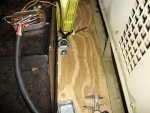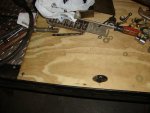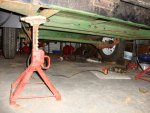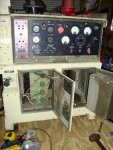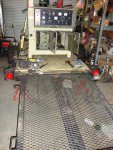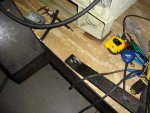Humpy
New member
- 62
- 1
- 0
- Location
- Springfield, South Carolina
Found a very nice trailer at a very good price on Craig's day before yesterday that was a new posting and yesterday I went to get it. Lucked out big time, I got there and after I paid him and hooked it up we were talking and he said he got another call from a guy in NC who said he was coming to get it a couple minutes after I told him I was on the way.
Extremely well made trailer and the guy hauled big Harleys and Hondas on for years . It is about 47 1/2" between the angle rails and 9 feet 9 3/4" long on the bed. The axle is about 3 feet from back end so I will mount the MEP for CG over the axle.
Does anyone know where the CG is on a 802a?
The PO said the wood floor finally gave up about 9 months ago and he replaced it with a piece of aluminum star plate.
While running the 802 sitting on my cargo trailer I noticed it vibrates the whole trailer but it can't move now as I have 2X6s screwed to the deck to keep it from moving while bring it from Ft. Bragg.
Obviously setting it on the aluminum star plate the skids are gonna do a number on the plate and most likely allow it to slide unless it is secured The star plate is only about 1/8" and the cross members under it are multiple C channel stock.
I am thinking two possible options, first is to get two 2X6X8ft and mount the gen to them with carriage bolts and secure it with chain binders like is displayed on the data plate on the side for flat car transport.
Next option is 3/4" stall mat from Tractor Supply made from ground up car/truck tires. They are 4X6 so large enough. Tough enough not to compress and not that expensive.
Another option is get a 3/4 piece of plywood and overdeck the back 8 feet of trailer, secure it with carriage bolts and bolt the plywood to the outer rails of the trailer.
The trailer frame and cross members are fabricated from 4" C channel. On top of that is angle 3" wide and 2" high and welded together. It has four eye bolts the PO secured Road King Harleys and Honda Gold Wings (800/900 lbs respectively) and he covered the US from midwest (Michigan/Iowa/Texas) hauling them to SC for rework and back for delivery. He estimates he pulled the trailer 20,000 miles with these bikes tied down so the generator weight should not be a factor.
The trailer has a axle with leaf springs and rides quite smooth with no load. The design is very well done and has the nicest brake/tail light housings I have ever seen and came with tractor trailer sealed lights in the rubber donuts which is what I have on several other trailers I own. They are completely enclosed and large enough to store replacement sealed bulb assemblies inside should one fail on the road.
There is also a nice heavy duty tilt down ramp that is removable. Also there is a channel fabricated from steel star plate for the bike wheels
At any rate I am open to other suggestions as I am sure a number of folks here have mounted big units. Not planning for it to be on the road that much (like it has been) but want to be able to back it into my shop where it will be protected from the elements and in the event of an emergency open the door, hook it to car/truck, pull it up to the wherever needed from home use to my volunteer fire dept use. We have gens on a rescue truck for scene lights/tools but not designed to be tied down for long term use.
Will see about posting some pics after while. Thanks yawl.
Extremely well made trailer and the guy hauled big Harleys and Hondas on for years . It is about 47 1/2" between the angle rails and 9 feet 9 3/4" long on the bed. The axle is about 3 feet from back end so I will mount the MEP for CG over the axle.
Does anyone know where the CG is on a 802a?
The PO said the wood floor finally gave up about 9 months ago and he replaced it with a piece of aluminum star plate.
While running the 802 sitting on my cargo trailer I noticed it vibrates the whole trailer but it can't move now as I have 2X6s screwed to the deck to keep it from moving while bring it from Ft. Bragg.
Obviously setting it on the aluminum star plate the skids are gonna do a number on the plate and most likely allow it to slide unless it is secured The star plate is only about 1/8" and the cross members under it are multiple C channel stock.
I am thinking two possible options, first is to get two 2X6X8ft and mount the gen to them with carriage bolts and secure it with chain binders like is displayed on the data plate on the side for flat car transport.
Next option is 3/4" stall mat from Tractor Supply made from ground up car/truck tires. They are 4X6 so large enough. Tough enough not to compress and not that expensive.
Another option is get a 3/4 piece of plywood and overdeck the back 8 feet of trailer, secure it with carriage bolts and bolt the plywood to the outer rails of the trailer.
The trailer frame and cross members are fabricated from 4" C channel. On top of that is angle 3" wide and 2" high and welded together. It has four eye bolts the PO secured Road King Harleys and Honda Gold Wings (800/900 lbs respectively) and he covered the US from midwest (Michigan/Iowa/Texas) hauling them to SC for rework and back for delivery. He estimates he pulled the trailer 20,000 miles with these bikes tied down so the generator weight should not be a factor.
The trailer has a axle with leaf springs and rides quite smooth with no load. The design is very well done and has the nicest brake/tail light housings I have ever seen and came with tractor trailer sealed lights in the rubber donuts which is what I have on several other trailers I own. They are completely enclosed and large enough to store replacement sealed bulb assemblies inside should one fail on the road.
There is also a nice heavy duty tilt down ramp that is removable. Also there is a channel fabricated from steel star plate for the bike wheels
At any rate I am open to other suggestions as I am sure a number of folks here have mounted big units. Not planning for it to be on the road that much (like it has been) but want to be able to back it into my shop where it will be protected from the elements and in the event of an emergency open the door, hook it to car/truck, pull it up to the wherever needed from home use to my volunteer fire dept use. We have gens on a rescue truck for scene lights/tools but not designed to be tied down for long term use.
Will see about posting some pics after while. Thanks yawl.
Last edited:




